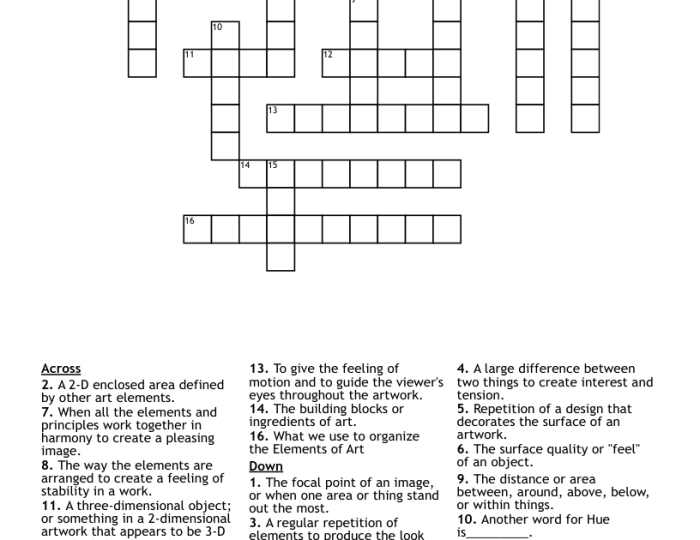Unveiling the Elements and Principles of Design Crossword Puzzle Answer Key, this comprehensive guide embarks on an enlightening journey into the fundamental building blocks of visual communication. Delving into the essence of design, this exploration unveils the interplay between elements and principles, empowering designers with the knowledge to create captivating and meaningful visual experiences.
Through a captivating narrative, this guide elucidates the seven elements of design—line, shape, color, texture, space, form, and value—and their transformative power in shaping visual compositions. It further explores the six principles of design—balance, contrast, emphasis, movement, pattern, and unity—and their role in orchestrating visual harmony and appeal.
Elements of Design: Elements And Principles Of Design Crossword Puzzle Answer Key

The elements of design are the fundamental components that make up any visual composition. There are seven elements of design:
- Line
- Shape
- Color
- Texture
- Space
- Value
- Form
These elements work together to create a cohesive design that communicates a message or evokes an emotion.
Line
Lines are the most basic element of design. They can be used to create a variety of effects, such as movement, direction, and emphasis.
Examples:A straight line can create a sense of stability, while a curved line can create a sense of movement.
Shape
Shapes are two-dimensional areas that are defined by lines. They can be used to create a variety of effects, such as contrast, balance, and unity.
Examples:A square can create a sense of stability, while a circle can create a sense of movement.
Color
Color is one of the most important elements of design. It can be used to create a variety of effects, such as mood, atmosphere, and emphasis.
Examples:Red can create a sense of excitement, while blue can create a sense of calm.
Texture
Texture is the surface quality of an object. It can be used to create a variety of effects, such as depth, interest, and contrast.
Examples:A rough texture can create a sense of age, while a smooth texture can create a sense of modernity.
Space
Space is the area around and between objects. It can be used to create a variety of effects, such as depth, balance, and unity.
Examples:Positive space is the area that is occupied by objects, while negative space is the area that is not occupied by objects.
Value
Value is the lightness or darkness of a color. It can be used to create a variety of effects, such as depth, contrast, and emphasis.
Examples:A light value can create a sense of airiness, while a dark value can create a sense of weight.
Form
Form is the three-dimensional shape of an object. It can be used to create a variety of effects, such as depth, interest, and contrast.
Examples:A cube has a three-dimensional form, while a sphere has a three-dimensional form.
Principles of Design

The principles of design are the guidelines that designers use to create effective visual compositions. There are six principles of design:
- Balance
- Contrast
- Emphasis
- Movement
- Pattern
- Unity
These principles work together to create a visually appealing design that is both effective and aesthetically pleasing.
Balance
Balance is the distribution of visual weight in a design. It can be achieved through the use of symmetry, asymmetry, or radial balance.
Examples:A symmetrical design is balanced around a central axis, while an asymmetrical design is balanced by the use of different weights on either side of the axis.
Contrast
Contrast is the difference between two or more elements in a design. It can be used to create a variety of effects, such as emphasis, interest, and depth.
Examples:Contrast can be created by using different colors, values, or textures.
Emphasis
Emphasis is the focal point of a design. It is the element that draws the viewer’s attention.
Examples:Emphasis can be created by using contrast, color, or size.
Movement
Movement is the path that the viewer’s eye takes through a design. It can be created by using lines, shapes, or colors.
Examples:Movement can be used to create a sense of excitement or to lead the viewer’s eye to a specific point.
Pattern
Pattern is the repetition of elements in a design. It can be used to create a variety of effects, such as unity, interest, and movement.
Examples:Patterns can be created by using lines, shapes, or colors.
Unity, Elements and principles of design crossword puzzle answer key
Unity is the sense of wholeness in a design. It is achieved through the use of common elements, such as color, texture, and shape.
Examples:Unity can be created by using a consistent color scheme or by using similar shapes throughout the design.
FAQ Corner
What are the seven elements of design?
The seven elements of design are line, shape, color, texture, space, form, and value.
What are the six principles of design?
The six principles of design are balance, contrast, emphasis, movement, pattern, and unity.
How do elements and principles work together in design?
Elements and principles work together to create visually appealing and effective designs. Elements provide the building blocks, while principles guide their arrangement and interaction.